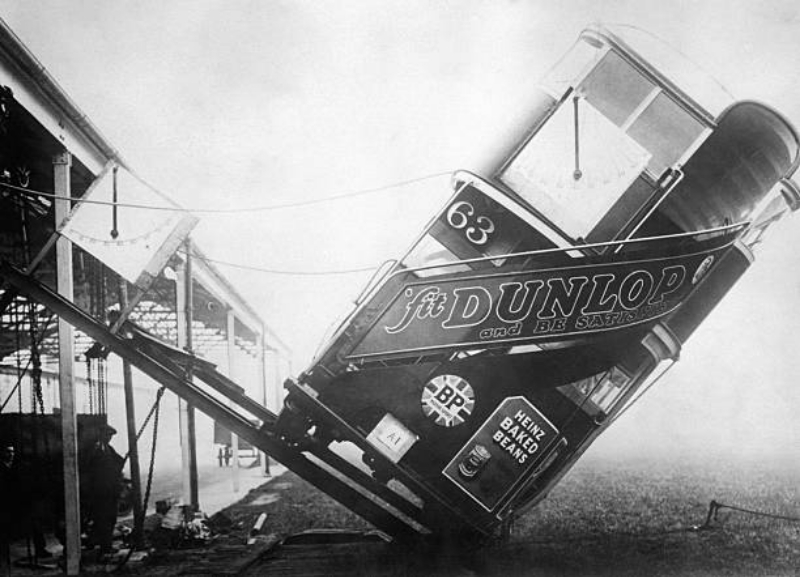No idea, Cynthia!!! I don't even see how the wheels and axle could get out from under the bus' body. That's crazy.How does that even happen?
The light's green.
You are using an out of date browser. It may not display this or other websites correctly.
You should upgrade or use an alternative browser.
You should upgrade or use an alternative browser.
Safety first
- Thread starter GGJaguar
- Start date
JerryR
Enlightened Member
- Joined
- May 2, 2007
- Messages
- 7,647
- Reaction score
- 643
Whichever way it's bus......t.No idea, Cynthia!!! I don't even see how the wheels and axle could get out from under the bus' body. That's crazy.
wileypickett
Enlightened Member
How he got up that ladder is the real mystery.
davismanLV
Venerated Member
- Joined
- Mar 24, 2011
- Messages
- 19,427
- Reaction score
- 12,346
- Location
- U.S.A. : Nevada : Las Vegas
- Guild Total
- 2
This is some of the stuff crazy horses do! Get into situations without a thought towards how they're gonna UNDO it.... I suppose you can back him up and then hope the entrance was on ground level on that side. Otherwise backing down stairs? They don't do that well at all!!
fronobulax
Bassist, GAD and the Hot Mess Mods
- Joined
- May 3, 2007
- Messages
- 24,792
- Reaction score
- 8,923
- Location
- Central Virginia, USA
- Guild Total
- 5
How he got up that ladder is the real mystery.
Juan / Horse On Balcony
Juan (Horse On Balcony) refers to an image of a horse standing on a balcony accompanied by the bottom text "Juan" which became the subject of jokes in 2020. The image of the horse on the balcony has been used in various image macros and photoshops since at least 2015, with the name "Juan" being...
plus other sources.
The most plausible answer, IMO, is that there are stairs that were used but are not in the picture and that the horse did not use the ladder
I suspect you're just not seeing the other side of the building.
You can lead a horse to a balcony but you can't make him get down...
walrus
walrus
JohnW63
Enlightened Member
There you go! A new saying.
JohnW63
Enlightened Member
What's going on in the horses head right now....?
Mmmm. That grass way over there looks tasty.
I can see my stall from here!
Hey! The guy said there was a water slide up here!
Mmmm. That grass way over there looks tasty.
I can see my stall from here!
Hey! The guy said there was a water slide up here!
adorshki
Reverential Member
adorshki
Reverential Member
adorshki
Reverential Member
I love Google Quora, thanks to Chris Judge, retired engineer of 50 yeas in Whaley Bridge, Great Britain, by way of crediting the source  :
:
If the top deck of a double decker London bus is completely filled with 220 pound people and there’s nobody downstairs, will it become dangerously top-heavy?
"The centre of gravity of an unloaded double-decker Optare bus is very low. It has 16 seats on the top deck. If they were all taken by 16 stone passengers then the extra weight on the top deck would be 1.6 tonnes. The kerb weight of the bus is 7.5 tonnes (7.35 long tons, 8.23 short tons). The bus is 14′5″ high (4.4m) the upper deck is 8′6″ (2.6m) above the kerb. The seats are 3ft (0.91m) above the upper deck The extra tilting moment of having the upper deck full of 16 stone passengers is thus:
(2.6 +0.91) x 1.6 x 1000 x g (9.81) = 55,000 Nm
The mass of the bus is 7.5 x 1000 x 9.81 = 74,000 N
Therefore the extra sitting passengers could tilt the bus 55/74 = 0.733 m (2′5″)
This is insufficient to tip the bus over. In fact the safety factor is 6/2.5 = 2.2
On a double decker bus tip test, it has to withstand a lean-out of 6 feet (1.8m). This is over twice the tilting moment caused by a deck full of sitting 20 stone passengers.

Now if you could get them all to stand up - it might be different."
And that, my friends, is safety at its finest.
And now I finally know why Count Five loved Double Decker Busses. Been wondering ever since 6th grade. Almost wore out the vinyl. Local San Jose band, y'know.
If the top deck of a double decker London bus is completely filled with 220 pound people and there’s nobody downstairs, will it become dangerously top-heavy?
"The centre of gravity of an unloaded double-decker Optare bus is very low. It has 16 seats on the top deck. If they were all taken by 16 stone passengers then the extra weight on the top deck would be 1.6 tonnes. The kerb weight of the bus is 7.5 tonnes (7.35 long tons, 8.23 short tons). The bus is 14′5″ high (4.4m) the upper deck is 8′6″ (2.6m) above the kerb. The seats are 3ft (0.91m) above the upper deck The extra tilting moment of having the upper deck full of 16 stone passengers is thus:
(2.6 +0.91) x 1.6 x 1000 x g (9.81) = 55,000 Nm
The mass of the bus is 7.5 x 1000 x 9.81 = 74,000 N
Therefore the extra sitting passengers could tilt the bus 55/74 = 0.733 m (2′5″)
This is insufficient to tip the bus over. In fact the safety factor is 6/2.5 = 2.2
On a double decker bus tip test, it has to withstand a lean-out of 6 feet (1.8m). This is over twice the tilting moment caused by a deck full of sitting 20 stone passengers.
Now if you could get them all to stand up - it might be different."
And that, my friends, is safety at its finest.
And now I finally know why Count Five loved Double Decker Busses. Been wondering ever since 6th grade. Almost wore out the vinyl. Local San Jose band, y'know.
Prince of Darkness
Senior Member
- Joined
- Feb 17, 2018
- Messages
- 3,609
- Reaction score
- 9,593
- Location
- Boddam, North East Scotland.
- Guild Total
- 2
I love Google Quora, thanks to Chris Judge, retired engineer of 50 yeas in Whaley Bridge, Great Britain, by way of crediting the source:
If the top deck of a double decker London bus is completely filled with 220 pound people and there’s nobody downstairs, will it become dangerously top-heavy?
"The centre of gravity of an unloaded double-decker Optare bus is very low. It has 16 seats on the top deck. If they were all taken by 16 stone passengers then the extra weight on the top deck would be 1.6 tonnes. The kerb weight of the bus is 7.5 tonnes (7.35 long tons, 8.23 short tons). The bus is 14′5″ high (4.4m) the upper deck is 8′6″ (2.6m) above the kerb. The seats are 3ft (0.91m) above the upper deck The extra tilting moment of having the upper deck full of 16 stone passengers is thus:
(2.6 +0.91) x 1.6 x 1000 x g (9.81) = 55,000 Nm
The mass of the bus is 7.5 x 1000 x 9.81 = 74,000 N
Therefore the extra sitting passengers could tilt the bus 55/74 = 0.733 m (2′5″)
This is insufficient to tip the bus over. In fact the safety factor is 6/2.5 = 2.2
On a double decker bus tip test, it has to withstand a lean-out of 6 feet (1.8m). This is over twice the tilting moment caused by a deck full of sitting 20 stone passengers.

Now if you could get them all to stand up - it might be different."
And that, my friends, is safety at its finest.
And now I finally know why Count Five loved Double Decker Busses. Been wondering ever since 6th grade. Almost wore out the vinyl. Local San Jose band, y'know.
This test is far from new. I have not been able to find out when it was introduced, but it was certainly in use by the early 1930s (and I think long before).

In order to pass, the bus has to be capable of being tilted to angle of greater than 28 degrees with all wheels maintaining contact.
I guess someone didn't like their car very much.
JerryR
Enlightened Member
- Joined
- May 2, 2007
- Messages
- 7,647
- Reaction score
- 643
Well at least the windshield didn't get broken
davismanLV
Venerated Member
- Joined
- Mar 24, 2011
- Messages
- 19,427
- Reaction score
- 12,346
- Location
- U.S.A. : Nevada : Las Vegas
- Guild Total
- 2
How does that even happen??? 


